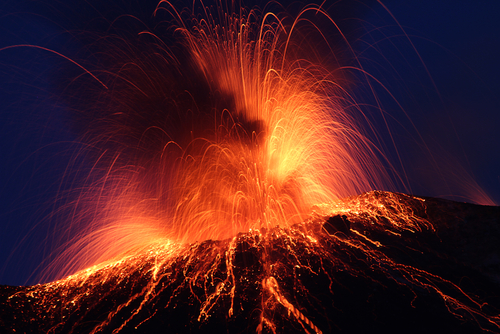10 – Most Active Volcano,
- Remember Hawaii’s Kilauea, the volcano that’s also a hot-tempered goddess (if you squint)? Well, this volcano, which makes up the entire south-eastern side of the Big Island of Hawaii, is the most active in the world.
- It’s had an explosive sixty-one recorded eruptions in its current cycle and, like the volcanic equivalent of multiple orgasms, has been continuously erupting since 1983. The only difference is that these eruptions have destroyed more than two hundred structures. Opps.
9 – Safe Zone,
- Most volcanoes occur near the edges of tectonic plates, which are the massive rock slabs that make up Earth’s surface.
- There are no active volcanoes in Australia because it’s situated in the middle of a tectonic plate. You’re safe here. So come on over, mate. We’ll chuck the barbie on. No worries.
8 – Acid Lake,
- In Indonesia’s Kawah-Idjen, an acid lake has formed in a volcanic crater. The lake is so toxic it can instantly burn through human flesh. It formed after absorbing the volcano’s gases and has extremely high sulphur concentrations.
- The lake water’s pH level is 0.5, making its contents essentially battery acid. It can eat away almost anything – even metal – and its fumes are lethal, so make sure you bring a gas mask.
- Volcanic eruptions here are particularly dangerous because they cause a shower of acid rain. The draining of the acid lake also causes deadly mudslides.
7 – Olympus Mons,
- Want to know where the largest volcano in our solar system is? Nope, it’s not in your pants; it’s on our favourite red planet, Mar.
- Olympus Mons has a staggering height of 25 km. This is almost three times the height of Mount Everest.
6 – Pumice Rock,
- Pumice is a form of volcanic rock that can float in water. Pumice stones are grey and full of small bubbly holes that form when hot gas jets out of a cooling rock.
- Just as nature intended, people use pumice stones to remove dead skin, stubborn dirt and calluses, and crushed pumice is often used in exfoliants.
- Pumice is also an important part of our construction industry. It’s crafted into breezer or cement blocks, which are stronger and lighter than red bricks and are often used in important weight-bearing walls.
- See, if it weren’t for volcanoes we’d still be flinging poo and living in mud huts.






